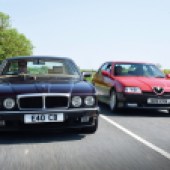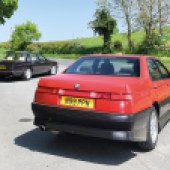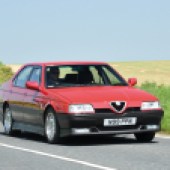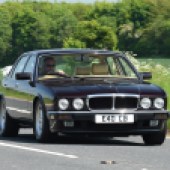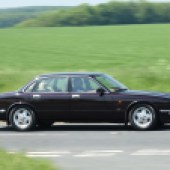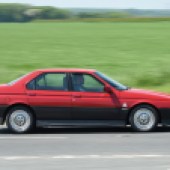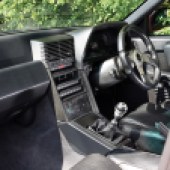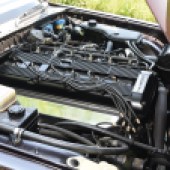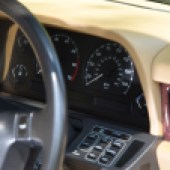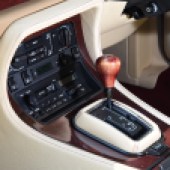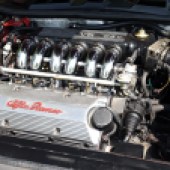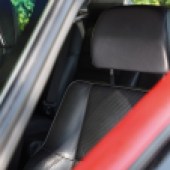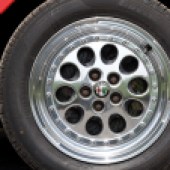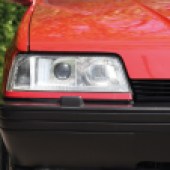The Alfa Romeo 164 and Jaguar XJ40 were each the final cars developed by their makers as independent marques. How do they stack up today?
Words: Craig Cheetham Images: Paul Walton
The best things come to those who wait – or at least that’s how the saying goes. Or, in the case of Jaguar during its period of British Leyland ownership and the drawn-out replacement for the XJ6, they don’t come at all. It took 14 years and a release from Leyland ownership to finally get the Jaguar XJ40 from the drawing board to the showroom; about six times the usual length of time for a new car’s development. The Alfa Romeo 164, by contrast, was ‘only’ a decade in gestation, which was still a woefully long time to wait compared with the norm. Yet, when both of these cars appeared, they were the most soulful and characterful of all the executive cars of the late 1980s and early 1990s – so, perhaps the old adage rings true after all?
In Jaguar’s case, there was a will to replace the XJ6 much sooner. The original plan for what would ultimately become the XJ40 was put into place in 1972, and by 1973 there were even design concepts floating around that were incredibly similar to the car that the new model would ultimately become. But, with no money in BL’s coffers and the need to improve volume models such as the Morris Marina and Austin Allegro first and foremost, the Jaguar was constantly put on a back burner.
It’s astonishing to think that the XJ40 was the last Jaguar to see a substantial level of involvement from the company’s founder, Sir William Lyons, or that it was originally signed off by Lofty England during his tenure as Jaguar chairman; by the time it appeared in 1986, Jaguar had seen unprecedented changes – a tumultuous period of Leyland ownership had seen the E-type replaced (by the bulkier, non-convertible XJ-S) and the XJ saloon put through two revisions, but left largely mechanically untouched to leave it (especially near the end) woefully out of date.
It took a return to independence after Michael Edwardes’ sell-off of Leyland’s non-essential businesses for Jaguar to finally crack on with the car and develop its AJ6 engine, something that the new Jaguar chairman, (Sir) John Egan, pushed through more rapidly than BL would sign-off a new door mirror. From 1984 to 1986, the XJ40 went from being passed around as an engineering concept (but rarely developed further) to being the most technologically advanced production Jaguar ever.
Meanwhile, in Italy, conversations between Fiat and Saab began in 1978. Both companies needed a new executive saloon and neither wanted to foot the development costs of such a car alone. For Saab, a bigger car to sit alongside the 900 was essential for it to maintain its independence. For Fiat, the Swedish firm’s reputation was hugely desirable – it built cars that were renowned for their enduring quality, and, at the time, Fiat and its additional brand, Lancia, had an unenviable reputation for corrosion and flaky build quality. The Fiat Argenta and Lancia Gamma were struggling to achieve volume sales in Italy, let alone in export markets.
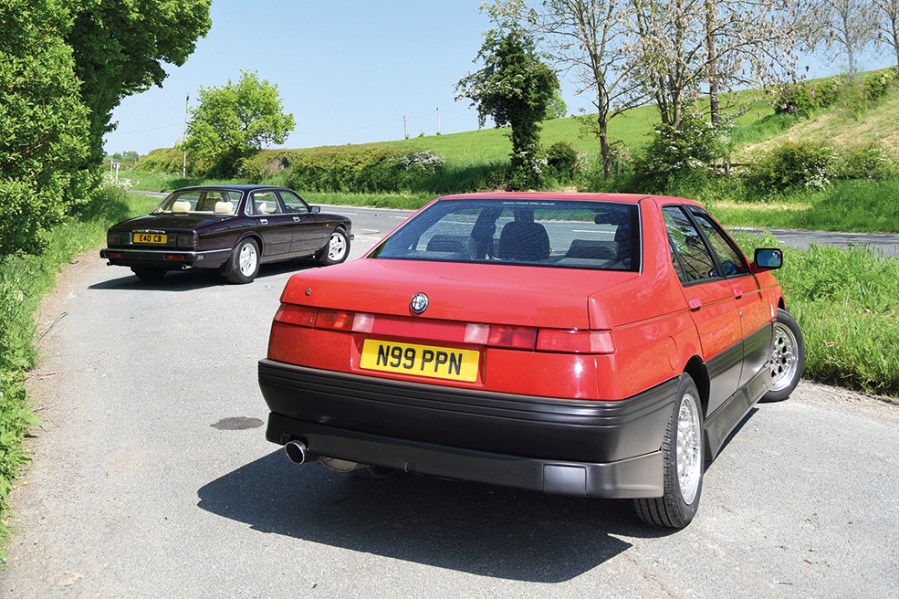
Similarly, the Italian Government-owned Alfa Romeo was struggling with its own build-quality issues and diminishing sales. The top-of-the-line Alfa 6 was hopelessly dated and a commercial flop. Alfa Romeo needed a new range-topper and didn’t want to spend a lot on development. The Milanese marque’s entire range was ripe for modernisation, and plans to work with (and part-fund) Fiat on the new project were in place long before Alfa Romeo actually became part of the Fiat stable in 1986.
The ‘Type Four’ programme was agreed in 1979, along with a short-lived plan to sell the Lancia Delta as the Saab 600 in Scandinavian markets. Under the programme, the Fiat Croma, Lancia Thema, Saab 9000 and Alfa Romeo 164 would all share the same platform, floorpan, rear suspension, electrical architecture, heating/ventilation system and four-speed ZF automatic transmission, where specified. Each would also maintain independence in terms of body styling and engine options, other than a midsection that needed to be the same thanks to the floorpan layout.
Though designed while still independent of Fiat, the Alfa Romeo 164 was released after the takeover and was the last to appear, previewed in 1987 but not put on sale until 1988, or 1989 in the UK. The 164 would prove to be the most individual of the group with its own unique, stylish Pininfarina body, as well as bespoke front steering and suspension.
It would also be a huge diversion for Alfa – its first large, front-wheel-drive car, with a fully galvanised body and a choice of four-cylinder or V6 engines, the latter of which sits closest to the XJ40 in terms of its appeal.
The 164 was marketed as the Alfa you could buy with your head as much as your heart – something that was believable in the late Eighties thanks to its galvanised body and much-improved build quality, but far less so now that the 164 is both rarer and a lot more fragile.
By contrast, the Jaguar is a much more sensible proposition, more so now than it was when it first launched underdeveloped, rust-prone and electrically temperamental. The early XJ40 was as risky as any Italian car for those traits, but by the time it went out of production, these had all been fixed.
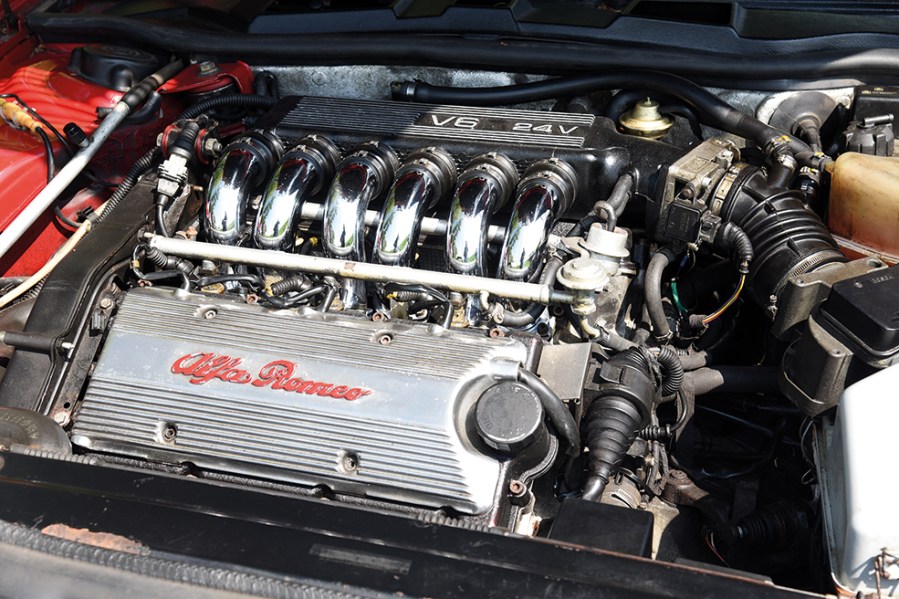
Which brings us neatly to the two cars we have here. A 1994 XJ40 4.0 S runout model and a 1996 164 3.0 24v V6, also from very late in the car’s life cycle, meaning both were as well-developed as they could hope to be. But which is the one that makes the most sense and truly stirs the soul?
If there was one thing that was a common theme in Eighties car styling it was boxiness. And both of these cars exhibit the styling of the era in their own unique way.
Starting with the Alfa, it has an undeniable slab-sidedness to it, with lots of square edges, rectangles and trapeziums in its styling. The body was the work of Pininfarina, and it’s arguably the best-looking of the Type Four saloons. For while it has lots of flat edges, the one thing the 164 most certainly achieves is handsomeness. It’s a great-looking car, with a purposeful wedge-shaped profile, pointed nose and kicked-up rear, the signature of which is a single reflective strip connecting both taillights.
There hadn’t been a car like it before, or since, and it looks amazing as presented here, in Alfa Romeo Racing Red with factory side skirts and ‘telephone dial’ alloy wheels.
The XJ40, by contrast, is much more refined and mature in its appearance. The car did away with the sinewy curves and peaked headlamps of early XJ models, bringing in the squarer front and rear end that defined its era; but, in profile, it was still unmistakably an XJ6, with the same drop-away rear end, curved screen and long, low bonnet that had always defined the model.
Two things are obvious here. First, that both are cars designed initially for the 80s, and second, that they’re two of the best-looking cars of their era. Both still look truly fabulous today.
When it comes to the cabin, though, there can only be one winner. Both are stylish inside, yet while each of these cars is comfortable and well-equipped, the Alfa Romeo cannot match the Jaguar’s sense of occasion. Like every XJ6, simply climbing into the XJ40 brings with it a feeling of accomplishment. You have to physically step in over a deep sill before lowering yourself into the ample leather seats. The dash is a huge slab of veneered wood, punctuated by a wide centre console. You sit a fair width away from your passenger, with the gear selector, radio and ‘ski slope’ between you. It’s a grand experience and quite regal, in a manner unique to British luxury models.
That’s not to say the Alfa doesn’t have its own appeal, of course. The cabin is taller and narrower than that of the Jaguar and the driving position is uniquely offset – something you notice more in a manual transmission example, such as this one. The fluted leather seats are really comfortable, but while the dashboard is stylish it’s also an ergonomic nightmare. Trying to work out the heater controls while on the move requires the kind of mental dexterity that most people don’t have, and while the slatted and slanted air vents look cool, the quality of some of the interior plastics would be much more at home on a Fiat Uno than inside an executive car of this calibre. But then, Italian cars are all about the driving…
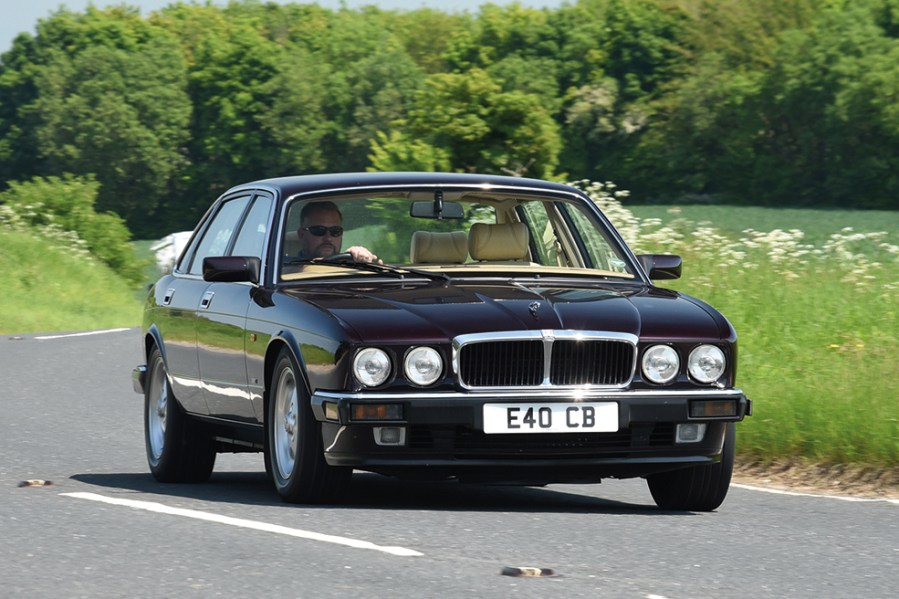
And it’s on the road where the Alfa really comes into its own. Yes, it may be a whole litre smaller in terms of overall engine capacity, but with 229bhp the V6 Cloverleaf model here is only 6bhp behind the 4-litre Jaguar straight-six. It sounds amazing, too, with a guttural exhaust note that rises to a howling crescendo as you open it up.
Then, there’s the steering. No executive car should have this sharp a turn-in, nor such precision on a twisty road. It goes exactly where you steer it, instantly and without delay. And it lets you know exactly where it’s going. For Alfa Romeo, enthusiastic drivers are and always have been the core of its customer base and that shows in the way the 164 behaves. There’s no over-assisted effort-free steering or comfort suspension here, just pure dynamic focus. It’s a terrific car, impossible not to enjoy and difficult to not drive the nuts off every time you get behind the wheel.
In many ways, the XJ40 is its polar opposite. Sure, it handles beautifully in the way that all Jaguar saloons do, but it does so in a much more serene and mature manner. It’s much softer, more detached, yet always reassuring. It’s as if the XJ40 was developed with more than just enjoyment at its core, as it’s a far more refined and cosseting experience as a result. As an all-rounder, it’s fabulous – but then that was always the XJ’s trump card. The ability to move along with both alacrity and grace while never feeling less than safe is what it does best, and this 4.0-litre model does so with appropriate gusto – albeit not as urgently as the Alfa. The XJ40 is a fine car to drive but it’s the Alfa that’s by far the most engaging.
Jaguar XJ40 vs Alfa Romeo 164: our verdict
So which of these two executive expresses is the better choice? In simple terms, the Jaguar stands head and shoulders above the Alfa Romeo. It’s sturdier, much more plush, far more of an all-rounder, easier to own and a lot more comfortable. So, an easy victory for Browns Lane?
No, not at all. Because while the XJ40 is undeniably a wonderful car, especially in this late and desirable specification and with the 4.0-litre engine, in the Alfa Romeo it meets a nemesis that’s far better than the sum of its parts.
The Jaguar has character and lots of it but the Alfa Romeo has soul. If you put both sets of keys down on a table it’s very hard not to pick up the ones to the 164. If you had a journey to complete that took you from one end of the country to the other, you’d take the Jaguar every time. But, at any other time, the Alfa will be the more rewarding and enjoyable car, so long as nothing goes wrong with it.
On this occasion, I can’t help it. My heart is ruling my head, and if you give me 24 hours to stew it over I may well change my mind. But, the Alfa Romeo wins.


